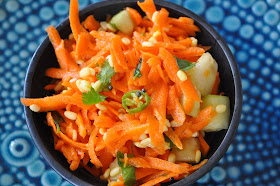If you have not had a chance to experience this, I would strongly suggest that you try it – eat a festival meal served on banana
leaf. This is an experience like no
other. When a meal is served on a banana
leaf, you know it is going to be special.
I grew up eating on banana leaf
for every festival or wedding that happened in our family. Since it was so much a part of my life, I
never really gave it much thought till my children experienced it for the first
time on one of our trips to India. Watching
them eat rasam sadam (rice and rasam) with their hand while trying desperately
to keep the rasam from flowing off the leaf was priceless!
We just got back from a really
short, hectic, but fantastic trip to India.
My husband’s nephew was getting married and my mom turned 75. The wedding was in Kumbakonam – very close to
where I went to college. We reached
Kumbakonam two days after landing in Chennai – totally jet-lagged, but ready to
enjoy the festivities. Food was amazing
and cooked in the traditional Tanjavoor style – and was
of course served on banana leaves.
One of the dishes in any Tamilian
thali meals – whether served on a plate or on a leaf – is the salad. We don’t have too much of a variety when it
comes to salads. There is sundal – which
can be considered a salad, and then there is kosumalli. Kosumalli is typically made with carrots or cucumbers and moong
dal. I love kosumalli because it is
really simple to make and tastes great.
Here is what you need:
- 2 – 3 carrots, washed, peeled, and grated
- 1 cucumber, peeled and diced into small pieces
- ½ cup split moong dal, soaked in water for 1 hour
- salt to taste
- 2 tsp. oil
- ½ tsp. mustard seeds
- ½ tsp. split urad dal
- ¼ tsp. hing (asafetida)
- 2 green chilies, chopped
- few curry leaves
- juice of one lemon or lime
- cilantro for garnish
Here is how I made it:
- In a bowl, mix the carrots, cucumber, drained moong dal, and salt. Set aside.
- Heat oil for tadka in a small sauce pan. Add mustard seeds. When they sputter, add the urad dal, hing, and green chilies.
- When the urad dal changes color, turn off the heat and add the curry leaves.
- Pour this over the salad. Add lime/lemon juice and cilantro. Mix well. Taste to adjust flavors.
Simple delicious salad is ready!








